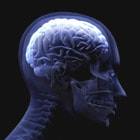|
Its Me Again! Deborah Marie - Peaching Around
NOVEMBER 15, 2011 From war injuries to football, to the plight and recovery of Congresswoman Gabby Giffords, brain injury has become one of the most-discussed topics in health care today. Brain injury encompasses a very large spectrum of possible problems with a variety of causes and potential outcomes. What happens when the brain is injured? This depends on a few factors:
The location of the injury can determine how the brain reacts. Generally, if you were to, say, bang your knee into the side of your desk, or accidentally skin it while biking, you will notice that a little swelling and bruising develops soon after. The same kind of process happens when the brain is injured. While your knee can handle a little swelling, your brain doesn’t react as well. Here’s why: (Source: http://www.bcs.org/content/conWebDoc/15499)
Your brain sits in your cranium, protected by the skull, and cushioned by cerebrospinal fluid (CSF). Given that the cranium is a bony chamber with no flexibility, if the brain were to swell, it increases intracranial pressure. The increased pressure puts added stress on the already injured brain, causing further complications and potentially death. Increased pressure in any system generally needs an outlet, a means of reducing pressure. If you think of moving tectonic plates, increased pressure in between two plates is released when they shift. Similarly, increased pressure within the brain can cause structures to shift if the pressure is high enough. This is called herniation. Depending on where the herniation occurs, the consequences can be devastating, especially if the brain is injured in or herniates into a location occupied by structures that are instrumental for basic processes such as respiration and heartbeat. The type of injury, as well as its extent, can also determine what happens. Blunt force trauma can affect a larger swath of brain tissue, compared to, say, a gunshot (depending on its trajectory). In the case of Gabby Giffords, the fact that bullet remained in the left hemisphere, rather than crossing hemispheres, or entering any higher or lower made a difference in her outcome. Repeated injury can also further potentiate damage, as is the case with repeated concussions seen in football players. Age can play a very key role in how the brain both reacts immediately following injury, as well as in the recovery period. The younger the patient is, the better the outcome, generally speaking. The benefit of being younger is that the skull bones have not fused completely, and there are intervening sections of flexible tissue known as fontanels. These exist for the sake of allowing the brain to grow, as would be expected in a growing child. In the setting of brain injury, though, the fontanels allow the brain to expand and thus relieve some of the pressure. Given that the brain is still fairly plastic, and able to more readily form new connections in response to the environment, recovery from brain injury can be more rapid. This isn’t to say older patients are not as likely to recover, because sometimes with enough stimulation and therapy, recovery can be possible. It’s important to respond to symptoms quickly. In the case of Gabby Giffords, the cause and relative extent and severity of the injury was known immediately, and care was provided rapidly. However, what if you bang your head hard against a surface? Sometimes it the severity is not known, and symptoms can be written off as less severe than they really are. The case of Natasha Richardson, the wife of Liam Neeson, comes to mind. She fell while skiing, and though was fine at the time, developed severe headaches later on. By the time help came, it was too late. Onset of severe headaches, disorientation, confusion, movement difficulties, among others, should not be ignored. These can be signs of increased intracranial pressure resulting from brain injury. Treatment options are varied. Attaching the patient to a ventilator to blow off extra carbon dioxide is one method of relieving some of the pressure. A decompressive craniectomy is another option, and involves moving part of the skull to allow the brain to swell. The bone flap is later put back during a procedure known as cranioplasty. Physical therapy, occupational therapy, speech therapy, and other interventions can help to rebuild connections lost as a result of injury. Again, as someone very interested in public health, my mantra is prevention, prevention, prevention. How do we prevent brain injuries? Safety is key. Wear helmets when engaging in sports that call for it. Wear your seat belt in the car. Football especially has become strongly associated with a risk for brain injury, and later risk of dementia pugilistica/CTE (a term that originally was coined due to the frequency seen in boxers). Rest is essential for recovery, whether in mild or more severe cases. The go-go-go mentality whether injured or not is absolutely the wrong approach for a player who has sustained a concussion in a sports setting, or for any person who has had a brain injury of any sort. As much as I love football, I would even go so far as to say that children should avoid playing the sport, given that the cumulative effects of all those hard hits and tackles could result in irreversible brain injury and dementia down the road. Too many football players have either died from or been diagnosed with the early stages of this condition. Until effective safety measures and new means of preventing injury are in place, it is probably not even worth taking the risk.
0 Comments
Leave a Reply. |
Archives
May 2024
Categories |

 RSS Feed
RSS Feed